Is the view camera obsolete?
by Carl Koch

The view camera with its movements covers typically professional applications. It is thus a vital tool of the professional photographer.
As however smaller hand cameras are simpler to operate, view camera popularity has tended to fluctuate from time to time. Yet this camera keeps returning to favour, despite its bulk and requirement of tripod mounting.
Let’s face it: many people associate the view camera and its movements with old-fashioned and cumbersome photography. As we shall see presently, they unfortunately have some grounds for this.
Medium-format and miniature cameras have benefitted from considerable advances in:
- optimum focusing
- simplified automatic operation
- faster shooting
View camera manipulation on the other hand has hardly changed since the era of the wooden camera. Large-format systems rarely bother with handling aids to smooth and error-free operation. And we don’t here mean technical gimmicks, but fundamentals of an up-to-date camera.


Focusing
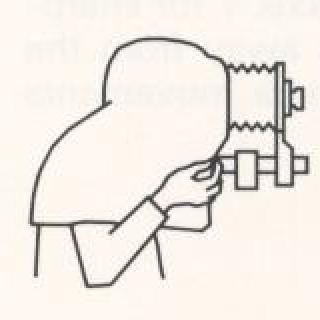
Let’s start with the vital step of focusing the image.
Photographers go to much trouble and expense to buy high-class lenses for their view camera. At the same time, no lens can ever perform better than it is focused. Yet in practice: does accurate focusing receive the same attention as choice of a high-class lens? Unhappily, as demonstrated below, indications seem to suggest otherwise.
- First of all, a basic point: Does it make sense to use a view camera without any precision aid to ground glass screen focusing and so risk wasting expensive lens performance?And does it make sense to have to stop down more than would otherwise be necessary?
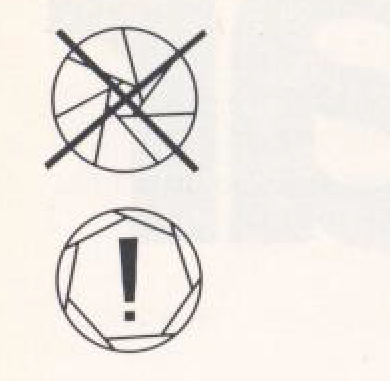
- The widespread view camera practice of checking depth of field and final focus with the lens stopped down to its working aperture -i.e. on a dim screen image -fails to make the most of modern lens performance. It hardly permits optimum focusing and makes no pretence of precision. Inevitably, that makes photographers stop down far too much•, to make sure of a safety margin.
An accurate depth of field scale is important also for exact creative sharpness control. Typically, view cameras lack this vital focusing aid -no wonder they are considered backward compared with other present-day photographic instruments.
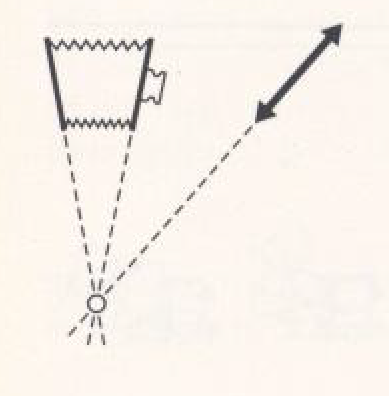
- A constant irritation with many view cameras is the fact that sharpness distribution control with the ,swings and tilts is a still weary succession of approximations and readjustments. You can do it only by trial and error, not by a logical step-by-step sequence. This method dates back to the old wooden camera -it not only wastes time and effort but again leaves optimum image control and focusing to chance. And that once more negates the performance of modern lenses.
Unfortunately such complications also restrict the photographer in his creative approach. So do the further points of technique below.

- The traditional central swing and tilt axis used to be regarded as particularly easy to handle. That was before the advent of the asymmetric tilt axis location in the film plane (or precise tilt angle measurement) with large setting bases and simple 2-point adjustment!

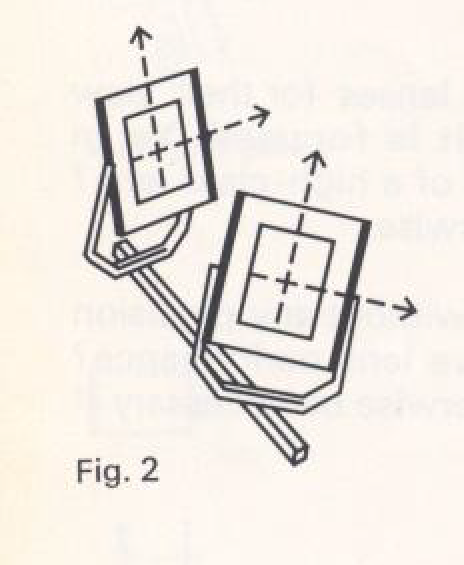
- A further factor complicating optimum focusing is that the swing and tilt axis of the camera may not match the axis marked on the ground glass screen. Here the photographer soon loses control of precise picture effects and is back to trialand-error operation. This may arise if for instance the camera has a rotating ground glass screen frame and you expose with the frame in an intermediate position (Fig. 1). A rising front adjustment then inevitably needs two movements (vertical and sideways) and swings and tilts become impossible to set precisely. A similar case of axis misalignment arises on inclining the camera (e.g. frequently for product shots). When even one standard swings about its vertical axis V, this then tips sideways away from the vertical, causing focusing problems (see Fig. 2 -here only for the image or lens standard). If both standards swing about the vertical axis V for sharpness distribution and perspective control, you may get multiple slants away from the vertical and the horizontal tilt axis which makes the effect of the camera movements quite unpredictable.
*You necessarily waste valuable film speed that way: For every f-stop smaller you need twice the amount of light in the studio, or twice as long an exposure time. Modern high-performance lenses yield optimum image quality at comparatively large to medium apertures. Excessive stopping down “to be on the safe side” thus reduces the lenses resolving power.

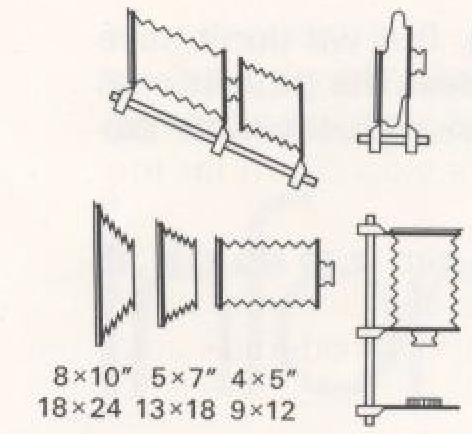
- When buying a new view camera, insist on interchangeable bellows, even at some extra cost, as this keeps all your lenses fully usable. Thus interchangeable bellows make the most of the rising and cross front movements, permit long extensions for product shots with long focal lengths, adapt the camera to different applications in a modular system and so on – all essential aspects of view camera versatility. Incidentally, a camera with fixed bellows is frequently incapable of conversion to a larger format, for instance for big instant pictures.

- It obviously makes sense to buy first class lens systems. It makes less sense to buy the camera itself by price rather than by insisting on performance to match what the lenses can do. This is all the more important as even the most advanced view cameras often cost only a fraction of what you pay for a first-class lens selection. Saving money here for the sake of saving is foolish economy. So make your choice by matching quality standards. For if you have to change the camera later, you often lose much more in money and possibly in performance. The extra you pay for a better view camera is always a worthwhile investment.
The taking sequence
Let us look at the taking sequence itself, with a full view camera outfit provided with current aids to simple and precise focusing. This is where the photographer must really devote his attention to the subject. Once more, it is where obsolete view camera features become particularly irritating.
- Thus the shutter on many view cameras still needs separate tensioning. (Amateur cameras did away with that half a century ago.)
- Aperture and shutter speed settings are frequently involved and difficult to do or read precisely, with scales of minute and crowded figures.
- Intermediate one-third stop settings, essentially in professional photography, are often impossible to set accurately (or at all) on the lens or shutter speed. That leads to exposure errors.
- Another nuisance, at best accepted as a necessary evil, is separate opening and closing of the shutter and aperture for ground glass focusing. No single-lens reflex would sell today with similarly complex and errorprone manipulation!
On any demanding photographic job such inconveniences and obstacles restrict the photographer and make optimum job handling impossible. Does this make sense – with a specifically professional tool?
Why must the professional put up with such obsolescence? The sad fact is that many professional photographers have quite wrong priorities. They continue to live with inefficient methods and inefficient equipment.
So unfortunately, there is good reason for the old-fashioned reputation of the view camera.
Yet by getting rid of these anachronisms the photographer could obviously get far more out of his camera and his lenses.
At first sight view cameras all tend to look alike. Only a closer look shows up differencies in real value.
Certainly the quality of a shot depends on the man behind the camera. But we don’t have to make his job more difficult than necessary by outdated camera features. The professional photographer is entitled to all the technical support he can get – even with the view camera and all its movements – to produce the best pictures.
So we have to look afresh at obsolete traditions and habits. SINAR‘s aim is to do this all along the way.



SINAR p-c-f cameras eliminate old-fashioned obstacles

More precise and simpler focusing and movement by:
More information in:
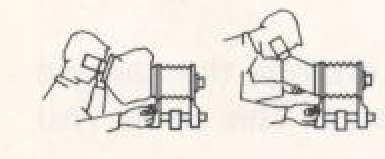
- Precise and faithful ground glass screen focusing with the SINAR binocular magnifier and binocular reflex magnifier (patented)
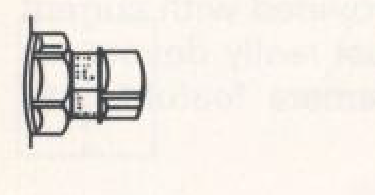
- More precise depth of field and focusing at full aperture with the SINAR depth of field scale: You focus on a bright screen image

- Simpler and more precise sharpness distribution control by:
- wing and tilt axis in the image plane, or
- precise angle settings (patented) instead of trial and error
SINAR Information 13:
feature No. 2, 3, 4, 5, 6, 7 and angle scale of the SINAR-f
SINAR-p
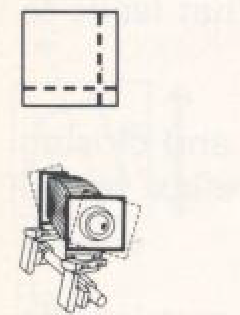
- Greater focusing base for more precise focusing (patented)
Simpler two-point settings
SINAR Information 13:
feature No. 4; also angle setting by scale with the SINAR-f
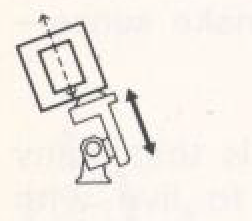
- Simpler focusing and movement control by matching camera movement axis and image axis with:
- yaw-free standards when the camera is inclined
- ground glass screen frame moves through 90° at a time, without rotation, but intermediate positions of the whole camera by side tilt about the rail
SINAR-p-c-f camera leaflets
see page 3. point 6
- More versatile applications of the camera and its lenses (extended camera system performance)
Modular camera system

- Matching potential performance of camera and lenses
Simplified exposure procedure with:
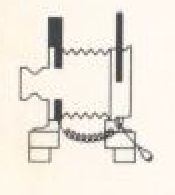
SINAR behind-lens shutter with automatic aperture and film holder control (patented)
SINAR Information 14:
“Closer shooting concentration – even with the view camera”
SINAR shutter leaflets: mechanical and electronic (DIGITAL)



